Petite Performers
Remember the days when huge tower speakers powered by beefy tube amplifiers and driven by a fine Scottish turntable were all the rage? Yeah, neither do I. But I do remember a time when I could bring home speakers and audio video components that were as finicky, as power-hungry and as space-wasting as can be, without any thought as to practicality. The MartinLogan 6-foot tall electrostatic speakers. The 250+ pound 20-inch deep Loewe 38-inch CRT HDTV. The Conrad-Johnson Premiere 11a tube power amp that runs so hot you can cook an egg on it (but boy, does it sound sweet!). And then a funny thing happened on the way to audio/video nirvana. Kids. And then a little thing called "priorities" came home to roost.
Apparently the little ones can burn their fingers on those pretty glowing tube amps, and their soft skin can bruise easily when massive tower speakers topple over onto their soft little noggins. So what's a poor audiophile turned semi-conscientious parent to do? That's where discreet, compact, yet powerful speakers like Atlantic Technology's System 2400 Series come into play.
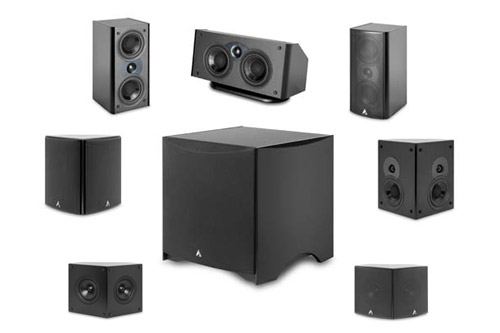
The System 2400 comprises a pair of 2400 LR front speakers ($650/pr.), a 2400 C center ($400), and one or two pairs of 2400 SR Surrounds ($700/pr.), depending on whether you need a 5.1 or 7.1 channel configuration. We went with a single pair of the 2400SRs in the rear, but also added on a pair of 1400 SR-z speakers ($425/pair) in the front for use as height channels for Dolby PLIIz listening. The 1400 SR-z and 2400 SR speakers can be set up as either dipole or bipole speakers depending on your preference. A 334SB 10" 220 watt powered subwoofer ($750) provided the low end oomph. Total system cost for this 7.1 channel system comes in just shy of $3000.
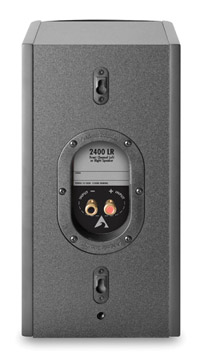
Bipolar: Not Just a Disorder
The Atlantic Technology 2400 SR surround and 1400 SR-z height channel speakers can be configured either in bipolar or dipolar mode via a switch on the back. In either case, drivers on each side of each enclosure emit sound in two directions for an immersive surround effect from the sides, front and/or rear of the room. In bipolar mode, the two drivers put out the exact same sound in two different directions. In dipolar mode, the sound from one side of the speaker is in phase while the other side is out of phase.
Dipolar configuration will generally create a more diffuse surround soundstage where it is difficult to pinpoint the location of the speakers (this is good for movies), but because the drivers are out of phase from each other, bass response can be compromised as can the overall sonic balance in areas outside the "sweet spot." Movie theaters frequently use dipolar surrounds. In comparison, bipolar speakers create a more discrete rear soundstage where you can hear the placement of sounds in the rear and side more clearly. This is good for many multi-channel music recordings, which rely on specific sonic placement of sounds throughout the entire surround soundstage to convey the producer's intended effect. Bipolar speakers are also excellent for movie viewing as they produce a more immersive rear surround field compared to direct radiating (monopole) speakers.
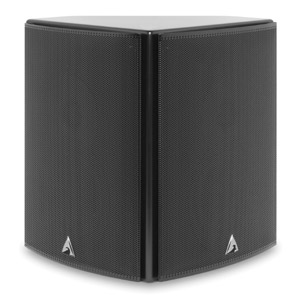
For most of our listening, we set the mode switch for the front height and rear surround speakers to "bipole" as this led to the most enjoyable results in our specific room, and for a diverse set of source material. But owners might like to experiment with both modes. If you use dipolar mode, be certain you arrange the speakers properly with the arrows pointing toward the front of the room (for side-mounting) or toward each other (rear wall-mounting and front height mounting).
The Set-Up
Plugging in all seven speakers was fairly straightforward, and wall-mounting the front height and rear surround speakers was only tricky because I had to fight to get masonry screws into my plaster-covered concrete walls. The actual mounting was a breeze due to the included cardboard templates and the keyhole mounts on the rear of the speakers. The subwoofer comes with all the necessary adjustments: crossover frequency dial as well as a switch to engage or disengage the crossover, phase adjustment (0/180), and gain (volume). The gain control is actually on the front behind the removable grille. This is more convenient than placing it on the rear of the unit, but less convenient than having the gain levels controlled by remote.
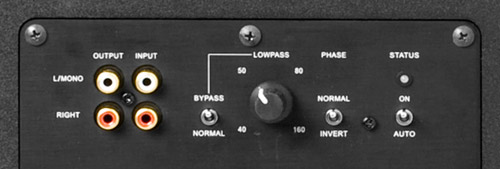
For starters, I ran through the Audyssey set-up of an Onkyo HT-RC160 receiver to adjust levels, delays and EQ. In my listening room, the Audyssey automatic adjustments were pretty close to ideal, with the crossover frequency set to 120 Hz for the center channel and 100 Hz on the main front/left speakers as well as the surrounds. I did have to tweak the distance settings for a couple of the speakers but these were also pretty close. With the bass management being done in the receiver, I switched the subwoofer's crossover control to "bypass." This configuration gave me the best blend between the subwoofer and the rest of the system. I also increased the subwoofer level slightly from where Audyssey put it, did some measurements via our trusty SPL meter, and settled in for some listening.
The Sound
Throughout my fairly extended evaluation, I had the opportunity to listen to a wide variety of sources, from 2-channel CDs to DVDs, to music and movie titles on Blu-ray Disc and even the occasional SACD disc. Sources included a Panasonic DMP-BD80 Blu-ray player and a Sony PS3, connected via HDMI to an Onkyo HT-RC160 receiver, configured for 5.1 plus height channels (Dolby PLIIz). For the most part, the sound of the system was enjoyable, accurate and dynamic, but the system was not without its limitations, mainly due to the size of the speakers.
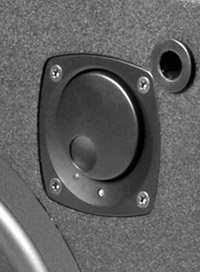
The Blu-ray version of "Drumline," with its 5.1 channel lossless DTS-HD Master Audio soundtrack, is another of my favorite discs to test out audio and the Atlantic Technology system proved no slouch here either. The dynamics and frequency extension of a live marching band can be hard to reproduce. From the low bass attack of the bass drums to the sharp blare of the horns to the sizzling crash of the cymbals, the Atlantic Technology system availed itself well, without congestion or confusion, tying these elements together into a tight cohesive blend. Even the snare drum sound effect in the disc menus sounded realistic, with a crisp and meaty snap.
Moving on to music, I spun up a few stereo CDs. On Pink Floyd's "Wish You Were Here," the guitars had a full, almost tangible presence and the vocals were nicely locked front and center, even when listening in pure stereo mode (just the two main speakers and subwoofer active). On the Mobile Fidelity Sound Labs version of Rush "2112," the spaciousness of the soundstage persisted, with the band taking on almost orchestral size and depth during the 2112 Overture, although there was a very slight edge to Geddy Lee's vocals.
For multi-channel music, Roxy Music's "Avalon" (SACD), brought me right back to the 80s, but with a discrete and smooth 5.1 channel mix that I never imagined back then listening to the stereo CD. The transparency and liquidity of the title track was represented well on the Atlantic Technology system with excellent harmonic balance and a seamless transition from satellite speakers to subwoofer. Subtle sonic details such as a touch of light percussion and keyboard accents revealed themselves around the room while the main instruments and vocals defined a deep wide soundstage across the front. Overall, the system provides a great sensation of space and depth that you just don't hear on entry-level systems.
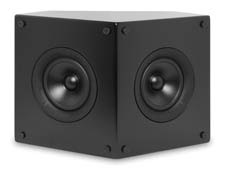
And while we're talking about going deep, we should also mention getting high, right? Height channels that is, via Dolby ProLogic IIz processing and the 1400 SR-z front height speakers. Although there is no content yet available with Dolby ProLogic IIz encoding, DPL IIz can extract height information from ambient sounds within most existing stereo and multi-channel recordings to create an illusion of height. Height channel speakers do not need to reproduce bass (so that can be small) and they are best placed in the front of the room at least 3 feet above your main left/right speakers.
I will say that switching in Dolby ProLogic IIz processing to engage the front height speakers did add a pleasant element of spaciousness to some material, both for movies and music. In the rain sequence near the beginning of "Ratatouille," the rain and gusts of wind come from all around and above you, adding a definite sense of immersion, a veritable wall of sound. And in the extended edition of "The Lord of the Rings: The Two Towers" (still only available on DVD, thank you very much, Warner), on disc II, chapter 3, the dream sequence has an even more spacious and ethereal quality than it has without the height speakers engaged. The bipolar/dipolar design of the 1400 SR-z creates a nicely diffuse height channel which blends well harmonically with the other System 2400 speakers. If you have a receiver capable of ProLogic IIz encoding, then I'd recommend picking up a pair of the 1400 SR-z speakers and experimenting with PLIIz to see if you like the effect. It's subtle but can be effective.
Turn Ons:
Turn Offs
Final Thoughts
If you're looking to upgrade the sound of an entry-level home theater or packaged HTiB system, or you want to move from large tower speakers to smaller bookshelve units without sacrificing sound quality, the Atlantic Technology System 2400 offers high quality sound in a very compact package for a relatively low price. At under $3000 for a 7.1-channel system (5.1 plus two height channels), or under $2500 for a 5.1 channel system, you'd be hard-pressed to find higher performance or a more refined and tasteful design. Also, the system's diminutive size and flexible wall or stand-mount installation options make it a perfect fit for a smaller to medium-sized rooms or anywhere you want to keep your system out of reach of those curious pint-sized explorers. Recommended.
Manufacturer's Specifications of System 2400 Components (as reviewed):
Model 2400LR (x2)
Model 2400C (x1)
Model 2400SR (x2)
Model 1400SR-z (x2)
334SB Powered Subwoofer (x1)
Manufacturers Contact Details:
Atlantic Technology
343 Vanderbilt Avenue
Norwood, MA 02062
Telephone: (781) 762-6300 | Fax: (781) 762-6868
Website: www.atlantictechnology.com
Where to Buy:
| Overall | |
|---|---|
| Value | |
| Performance | |
| Features/Ergonomics |